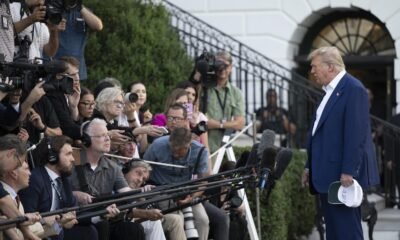2024 election
US Voters Shun Female Presidential Hopefuls – What’s Needed for a Woman to Prevail?

WASHINGTON – Women have governed nearly a third of the world’s nations as presidents, prime ministers, and chancellors. However, Vice President Kamala Harris’ recent loss has reinforced the long-standing glass ceiling in the United States.
“It absolutely will happen,” remarked Jean Sinzdak, associate director of the Rutgers Center for American Women and Politics, adding that change is unlikely to occur soon.
In a historic development, Claudia Sheinbaum was sworn in as Mexico’s first female president last month. Margaret Thatcher, the UK’s first woman to hold the prime minister role, served from 1979 to 1990, making her one of the longest-serving leaders in British history. Similarly, Germany’s Angela Merkel led from 2005 to 2021, and Indira Gandhi became India’s first female prime minister in 1966, just ahead of Golda Meir in Israel.
Despite advances, the U.S. lags significantly behind global counterparts. According to Kim Fridkin, a political scientist at Arizona State University, there has been increased success for women in statewide offices, but the presidential arena remains challenging.
Currently, out of 193 member states in the United Nations, 13 have female leaders—a record number, with nine being first-time occupants of such roles. Historically, 60 nations have been led by women since Sri Lanka’s groundbreaking leadership in 1960.
In the U.S., 45 men have held the presidency, with Donald Trump being both the 45th and 47th president. Major parties did not nominate a woman for the presidency until 2016, when Hillary Clinton, after a brief 2008 bid, secured the Democratic nomination but ultimately lost to Trump.
Geraldine Ferraro’s nomination as vice president in 1984 represented a significant breakthrough, as did John McCain selecting Sarah Palin in 2008. Kamala Harris became the third woman vice-presidential nominee when she joined Joe Biden’s ticket in 2020, ultimately making history as the first female vice president.
Out of the G7 nations, five have been led by women, leaving only Japan and the U.S. as outliers. Only one female prime minister has served in Canada, and in the G20, 14 members have appointed women to lead, including Argentina and the European Union.
Many experts see cultural factors influencing women’s status in politics. According to Sinzdak, certain countries provide more support for women’s advancement. In contrast, the structure of the U.S. political system, which is presidential rather than parliamentary, complicates the pathway to leadership.
In a parliamentary system, parties nominate leaders who can be voted into power, whereas a U.S. president can only be removed under extreme circumstances. This difference can deter political parties from promoting female candidates for high office.
Recruitment for government positions remains male-dominated, creating challenges for women aspiring for national roles. Sinzdak emphasized that parties must actively seek to place women in lower offices to encourage upward mobility.
Though 60 women have served in the U.S. Senate—25 currently in office, including Arizona’s retiring Sen. Kyrsten Sinema—the pace of gender balance remains slow. Consequently, it could take another 90 years for Congress to achieve gender parity, according to political analysts.
Arizona’s history of electing women to significant positions is noteworthy. The state was the first to have five women serve as governors, and the “Fab Five” in 1998 marked a significant moment in statewide leadership.
Despite Arizona’s progressive electoral record, challenges remain. Political consultant Paul Bentz noted that beyond gender, factors such as campaign strategy and the intensity of opposition played significant roles in Harris’ defeat.
Fridkin highlighted that women candidates often navigate a complex balancing act, needing to demonstrate both leadership strength and adherence to societal expectations. Comedic references by figures like Michael Che illustrate the broader societal challenges faced by women in politics.
The corporate world also mirrors such disparities. Currently, only 10% of Fortune 500 CEOs are women, highlighting systemic issues across various sectors.
Sinzdak remains optimistic, viewing Harris’ role as vice president and candidate as a step toward normalizing female participation in presidential politics. “Women are now part of the presidential election process,” she stated, noting the shift in perceptions surrounding women in leadership roles.


















